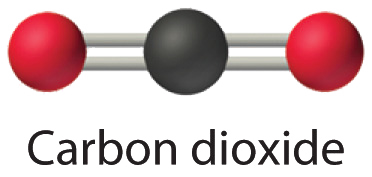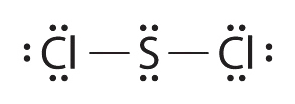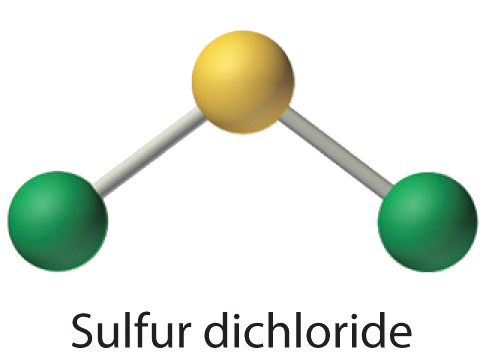3.7 Lewis Structures
- Page ID
- 142206
Skills to Develop
- To use Lewis dot symbols to explain the stoichiometry of a compound
We begin our discussion of the relationship between structure and bonding in covalent compounds by describing the interaction between two identical neutral atoms—for example, the H2 molecule, which contains a purely covalent bond. Each hydrogen atom in H2 contains one electron and one proton, with the electron attracted to the proton by electrostatic forces. As the two hydrogen atoms are brought together, additional interactions must be considered (Figure \(\PageIndex{1}\)):
- The electrons in the two atoms repel each other because they have the same charge (E > 0).
- Similarly, the protons in adjacent atoms repel each other (E > 0).
- The electron in one atom is attracted to the oppositely charged proton in the other atom and vice versa (E < 0). Recall that it is impossible to specify precisely the position of the electron in either hydrogen atom. Hence the quantum mechanical probability distributions must be used.

Figure \(\PageIndex{1}\): Attractive and Repulsive Interactions between Electrons and Nuclei in the Hydrogen Molecule. Electron–electron and proton–proton interactions are repulsive; electron–proton interactions are attractive. At the observed bond distance, the repulsive and attractive interactions are balanced.
A plot of the potential energy of the system as a function of the internuclear distance (Figure \(\PageIndex{2}\)) shows that the system becomes more stable (the energy of the system decreases) as two hydrogen atoms move toward each other from r = ∞, until the energy reaches a minimum at r = r0 (the observed internuclear distance in H2 is 74 pm). Thus at intermediate distances, proton–electron attractive interactions dominate, but as the distance becomes very short, electron–electron and proton–proton repulsive interactions cause the energy of the system to increase rapidly. Notice the similarity between Figures \(\PageIndex{1}\) and \(\PageIndex{2}\), which described a system containing two oppositely charged ions. The shapes of the energy versus distance curves in the two figures are similar because they both result from attractive and repulsive forces between charged entities.
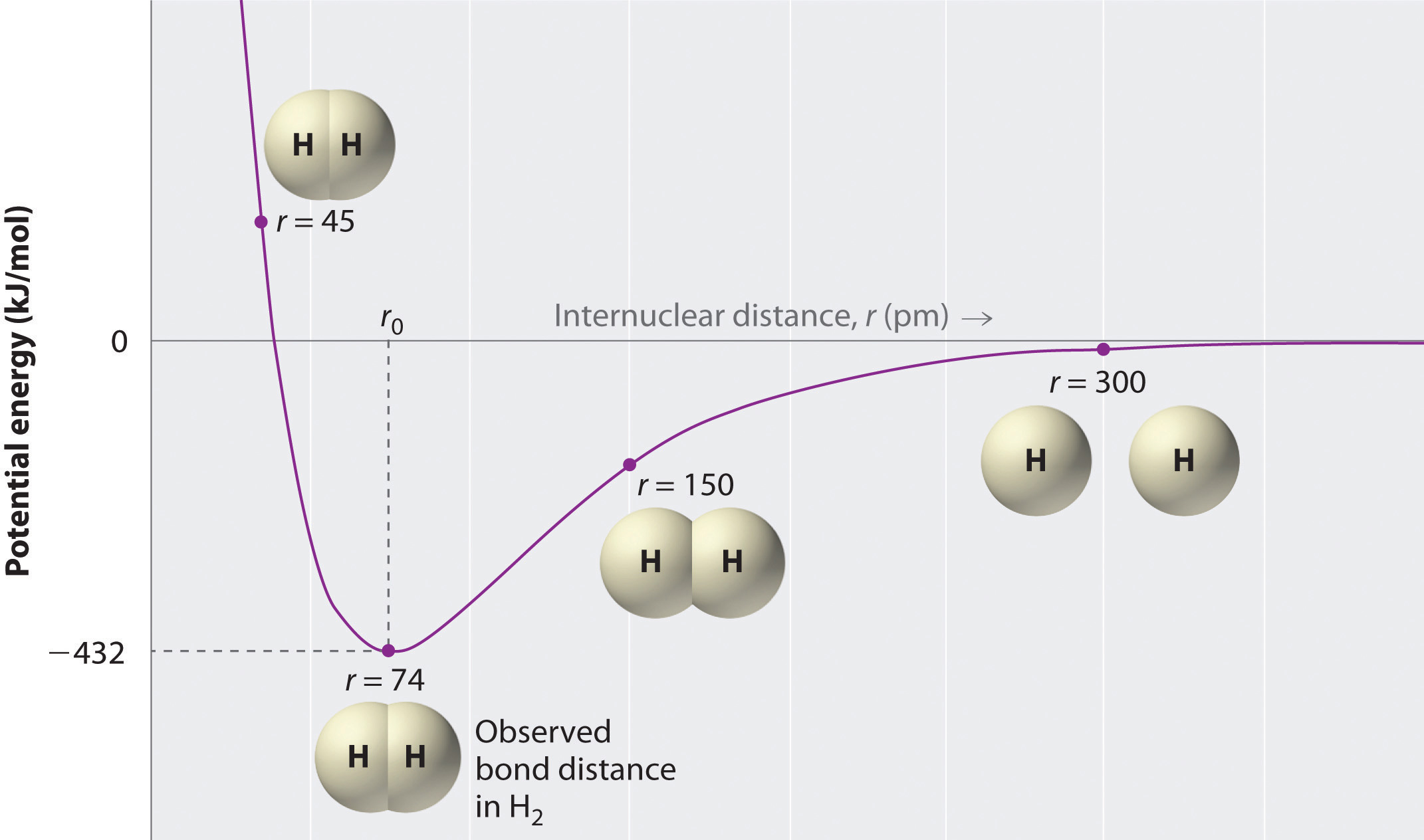
Figure \(\PageIndex{2}\): A Plot of Potential Energy versus Internuclear Distance for the Interaction between Two Gaseous Hydrogen Atoms.
At long distances, both attractive and repulsive interactions are small. As the distance between the atoms decreases, the attractive electron–proton interactions dominate, and the energy of the system decreases. At the observed bond distance, the repulsive electron–electron and proton–proton interactions just balance the attractive interactions, preventing a further decrease in the internuclear distance. At very short internuclear distances, the repulsive interactions dominate, making the system less stable than the isolated atoms.
Using Lewis Dot Symbols to Describe Covalent Bonding
It is usually easier to figure out a problem if you can draw a picture, either mental or real, of what is happening. This is often done in physics and mathematics, and it is especially helpful when looking at the bonding, structure, physical properties, and reactivity of compounds.
The most common picture, or model, of elements and compounds used is the Lewis Dot Structure. These pictures show you the type(s) of atom(s) involved, their position in the molecule, and where their valence electrons are situated.
To draw structures of substances you need to know:
1. the electronegativities of the elements so that you can decide if the atoms form ionic bonds or covalent bonds.
2. the number of valence electrons so that you can determine what ions will likely form (if the bonding will be ionic) or how many electrons will need to be shared in bonds (if the bonding will be covalent.)
GENERAL TERMS FOR LEWIS DOT STRUCTURES:
1. ![]() Dot • one dot represents one valence electron (found on odd-electron particles)
Dot • one dot represents one valence electron (found on odd-electron particles)
2. ![]() Pair of Dots •• a pair of dots represents a nonbonding (lone) pair of electrons that are not involved in a covalent bond and "belong to" only one atom
Pair of Dots •• a pair of dots represents a nonbonding (lone) pair of electrons that are not involved in a covalent bond and "belong to" only one atom
3. Dash each dash represents two electrons that are shared between two atoms as a covalent bond.
One dash — a single bond; one set of two electrons shared; also a sigma (σ) bond
Two dashes = a double bond; two sets of two electrons shared; one sigma (σ) and one pi (π) bond
Three dashes  a triple bond: three sets of two electrons shared; one sigma and two pi (π) bonds
a triple bond: three sets of two electrons shared; one sigma and two pi (π) bonds
The valence electron configurations of the constituent atoms of a covalent compound are important factors in determining its structure, stoichiometry, and properties. For example, chlorine, with seven valence electrons, is one electron short of an octet. If two chlorine atoms share their unpaired electrons by making a covalent bond and forming Cl2, they can each complete their valence shell:
![]()
Each chlorine atom now has an octet. The electron pair being shared by the atoms is called a bonding pair; the other three pairs of electrons on each chlorine atom are called lone pairs. Lone pairs are not involved in covalent bonding.
We can illustrate the formation of a water molecule from two hydrogen atoms and an oxygen atom using Lewis dot symbols:
![]()
The structure on the right is the Lewis electron structure, or Lewis structure, for H2O. With two bonding pairs and two lone pairs, the oxygen atom has now completed its octet. Moreover, by sharing a bonding pair with oxygen, each hydrogen atom now has a full valence shell of two electrons. Chemists usually indicate a bonding pair by a single line, as shown here for our two examples:
![]()
In CHM 120, you should always use lines to represent bonds. The use of dots will be reserved for non-bonding (lone) electron pairs.
The following procedure can be used to construct Lewis electron structures for more complex molecules and ions:
Skills to Develop
THE EASY METHOD PROCEDURE TO DETERMINE A LEWIS DOT STRUCTURE
In this process, the basic concept of this method is that all valence electrons present will be taken away from the individual atoms and pooled together. They will first be doled out to form the requisite number of bonds. The remaining valence electrons will then be added to individual atoms as lone pairs to complete the octet of each atom.
1. Calculate the total number of valence electrons required for each atom to have an octet, or eight valence electrons. The major exception to this rule is that hydrogen wants only two (2) valence electrons. The other two most commonly-occurring exceptions are Be (4) and B (6) valence electrons.
Thus, the process for step one is 2 x (# of H atoms) + 8 x (# of most other atoms) = valence electrons needed
2. Calculate the total number of valence electrons in the given species.
If you have a polyatomic anion, you must add the number of '-' charges because there are extra valence electrons.
If you have a polyatomic cation, you must subtract the number of '+' charges because there are missing valence electrons.
3. Subtract result 2 from result 1. This is the number of valence electrons lacking for each atom to have its own octet. This number of electrons will have to be shared in bonds.
4. Divide result 3 by two, because there are two electrons per bond. This is the number of covalent bonds you must use!
5. Connect the atoms in the formula together with the number of bonds from result 4. Helpful hints:
i) H atoms form only one bond.
ii) The first atom in the formula is usually the central atom to which the other atoms bond
iii) If the particle has only three atoms, and each atom is of a different element, the atom in the middle of the formula is usually in the middle of the structure.
iv) species are as symmetrical as possible when there are several central atoms
v) For neutral species:
Group IV atoms usually form four bonds
Group V atoms usually form three bonds
Group VI atoms usually form two bonds
Group VII atoms usually form one bond
6. Add in electrons as non-bonding pairs or lone pairs (groups of two), so that each atom has eight electrons around it.
7. Count the total number of electrons in the structure. The number should be equal to the number of electrons in result 2.
CAUTIONS:
1. Never put a lone pair on an H atom.
2. The only common substances that have a lone pair on a C atom are CO and CN-. Other than those two particles, you should not put a lone pair on a C atom.
Now let’s apply this procedure to some particular compounds, beginning with one we have already discussed.
The central atom is usually the least electronegative element in the molecule or ion; hydrogen and the halogens are usually terminal.
The \(H_2O\) Molecule
- (1 O atom) x (8) + (2 H atoms) x (2) = 12 valence electrons needed
- (1 O atom) x (6) + (2 H atoms) x (1) = 8 valence electrons present.
- 12-8 = 4 electrons short, thus 4 electrons must be shared
- 4 shared electrons/ 2 electrons per bond = 2 bonds
- Connect the each of the two H atoms to the O atom with one single bond each.
- Add the remaining 4 electrons to the oxygen (as two lone pairs) to give the following structure:

This is the Lewis structure we drew earlier. Because it gives oxygen an octet and each hydrogen two electrons, we do not need to use step 6.
The \(OCl^−\) Ion
- (1 O atom) x (8) + (1 Cl atom) x (8) = 16 valence electrons needed
- (1 O atom) x (6) + (1 Cl atom) x (7) + 1 = 14 valence electrons present.
- 16 - 14 = 2 electrons short, thus 2 electrons must be shared
- 2 shared electrons/ 2 electrons per bond = 1 bond
- Connect the two atoms with one single bond .
- Add the remaining 12 electrons as lone pairs, with 3 pairs on the O atom and 3 pairs on the Cl atom, giving the following structure:

Each atom now has an octet of electrons. The Lewis electron structure is drawn within brackets as is customary for an ion, with the overall charge indicated outside the brackets, and the bonding pair of electrons is indicated by a solid line. OCl− is the hypochlorite ion, the active ingredient in chlorine laundry bleach and swimming pool disinfectant.
The \(CH_2O\) Molecule
- (1 O atom) x (8) + (1 C atom) x (8) + (2 H atoms) x (2) = 20 valence electrons needed
- (1 O atom) x (6) + (1 C atom) x (4) + (2 H atoms) x (1) = 12 valence electrons present.
- 20 - 12 = 8 electrons short, thus 8 electrons must be shared
- 8 shared electrons/ 2 electrons per bond = 4 bonds
- Because carbon is less electronegative than oxygen and hydrogen is normally terminal, C must be the central atom. Connect the two H atoms and the O atom to the C atom with with one single bond each, giving the structure:

6. There is still one more bond that you must use in the structure. At this point, the C atom has only three bonds and the O atom has only one bond. Thus, putting one more bond between the C and the O, creating a double bond, will satisfy all bonding requirements.
7. Add the remaining 4 electrons as two lone pairs on the O atom, giving the following structure:

Both the oxygen and the carbon now have an octet of electrons, so this is an acceptable Lewis electron structure. The O has two bonding pairs and two lone pairs, and C has four bonding pairs. This is the structure of formaldehyde, which is used in embalming fluid.
An alternative structure can be drawn with one H bonded to O. Formal charges, discussed later in this section, suggest that such a structure is less stable than that shown previously.
Example \(\PageIndex{1}\)
Write the Lewis electron structure for each species.
- NCl3
- S22−
- NOCl
Given: chemical species
Asked for: Lewis electron structures
Strategy:
Use the six-step procedure to write the Lewis electron structure for each species.
Solution:
- NCl3 Determine number of bonds needed
- (1 N atom) x (8) + (3 Cl atoms) x (8) = 32 valence electrons needed
- (1 N atom) x (5) + (3 Cl atoms) x (7) = 26 valence electrons present.
- 32 - 26 = 6 electrons short, thus 6 electrons must be shared
- 6 shared electrons/ 2 electrons per bond = 3 bonds
- Nitrogen is less electronegative than chlorine, and halogen atoms are usually terminal, so nitrogen is the central atom. Connect the three Cl atoms with the central N atom with three single bonds.
- You have used 6 electrons. Add the remaining 20 electrons on to the structure as lone pairs, to ensure that each atom has an octet (1 lone pair for N, and 3 lone pairs for each Cl.)

Nitrogen trichloride is an unstable oily liquid once used to bleach flour; this use is now prohibited in the United States.

b. S22- ion Determine number of bonds needed
1. (2 S atoms) x (8) = 16 valence electrons needed
2. (2 S atoms) x (6) + 2 = 14 valence electrons present.
3. 16-14 = 2 electrons short, thus 2 electrons must be shared
4. 2 shared electrons/ 2 electrons per bond = 1 bond
5. Connect the each of the two S atoms with one single bond each.
6. You have used two electrons. Add the remaining 12 electrons to the S atoms (as three lone pairs per S atom) to give the following structure:
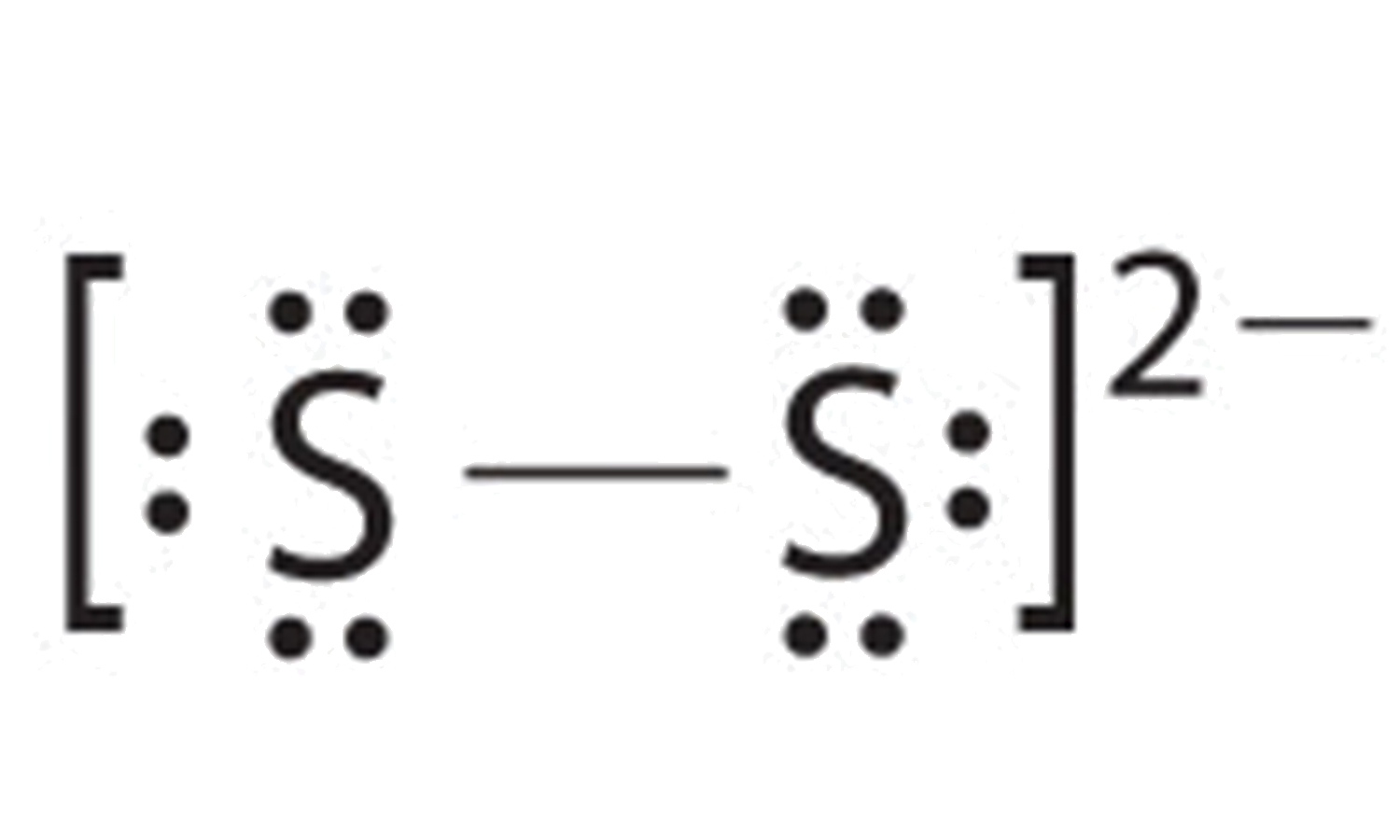
c. NOCl Determine number of bonds needed
- (1 N atom) x (8) + (1 O atom) x (8) + (1 Cl atom) x (8) = 24 valence electrons needed
- (1 N atom) x (5) + (1 O atom) x (6) + (1 Cl atom) x (7)= 18 valence electrons present.
- 24-18 = 6 electrons short, thus 6 electrons must be shared
- 6 shared electrons/ 2 electrons per bond = 3 bonds
- Because nitrogen is less electronegative than oxygen or chlorine, it is the central atom. Also, this molecule falls into the category of a particle that has only three atoms, and each atom is of a different element, so the atom in the middle of the formula is usually in the middle of the structure. Placing one bonding pair of electrons between each pair of bonded atoms uses 4 electrons and gives the following:
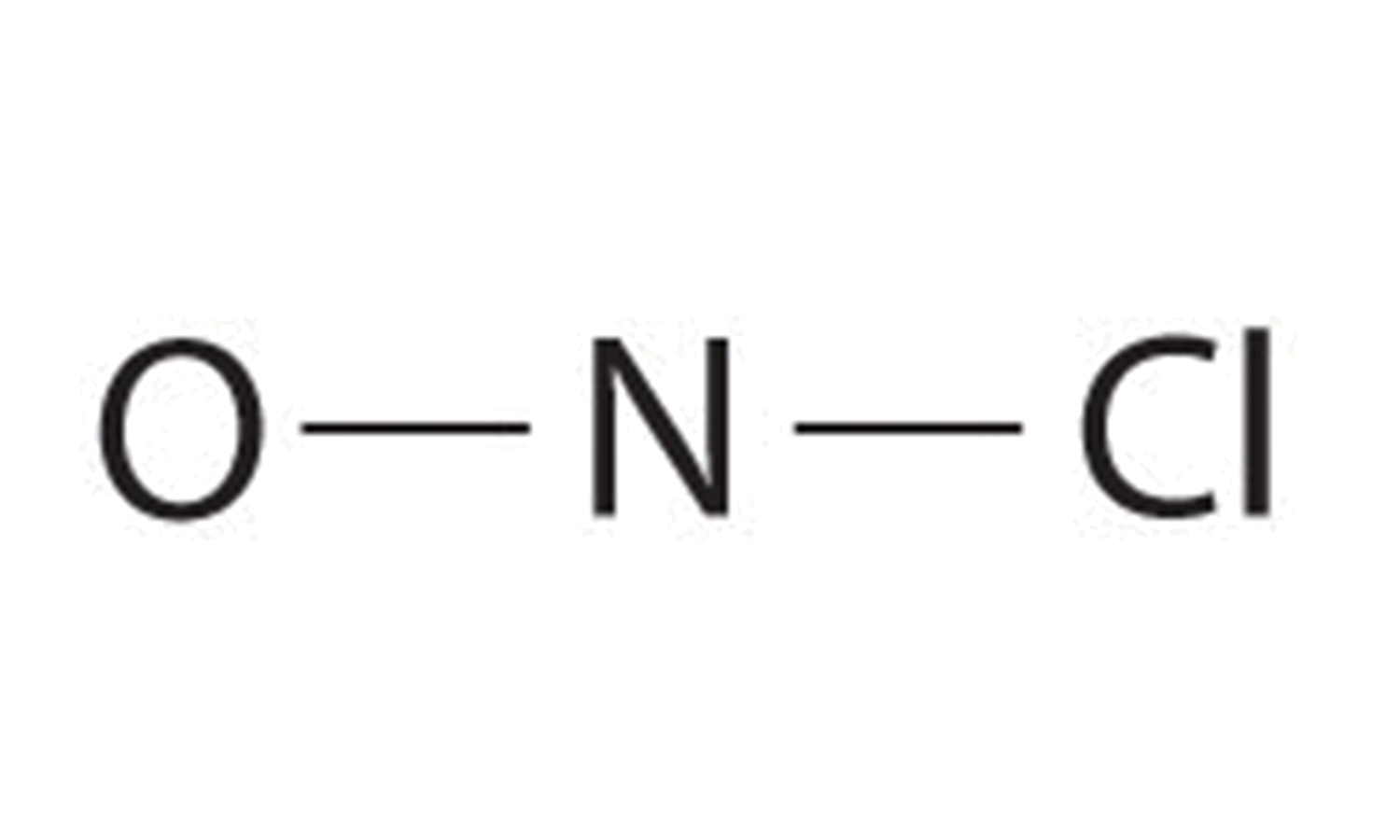
6. There is still one more bond that you must use in the structure. At this point, the N atom has only two bonds and the O atom has only one bond. Thus, putting one more bond between the N and the O, creating a double bond, will satisfy all bonding requirements. The Cl, as a halogen, is stable with just one bond.
7. You have used 6 electrons. Add the remaining 12 electrons as two lone pairs on the O atom, one lone pair on the N atom, and three lone pairs ion the Cl atom giving the following structure:
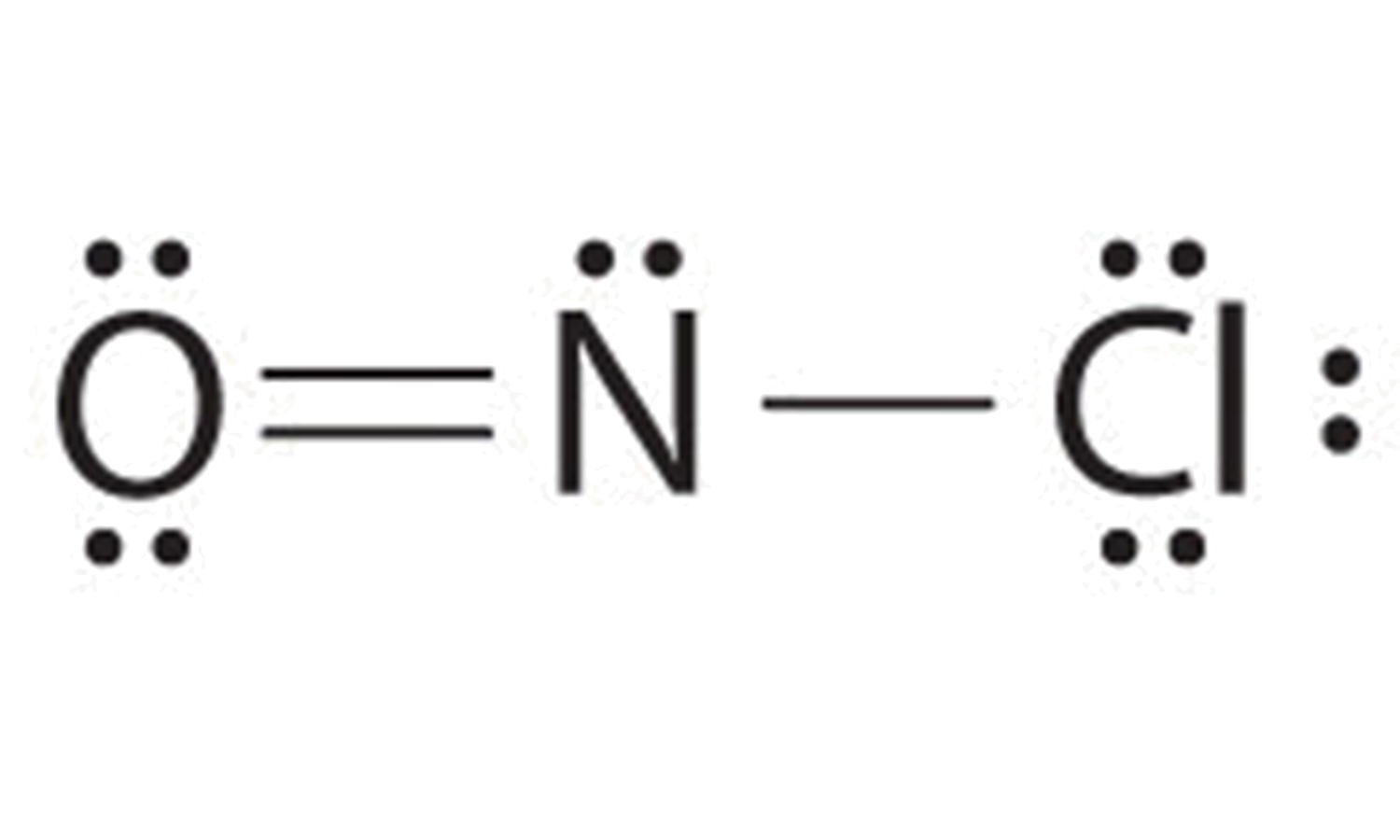
All atoms now have octet configurations. This is the Lewis electron structure of nitrosyl chloride, a highly corrosive, reddish-orange gas.

Exercise \(\PageIndex{1}\)
Write Lewis electron structures for CO2 and SCl2, a vile-smelling, unstable red liquid that is used in the manufacture of rubber.
Answer:
Using Lewis Electron Structures to Explain Stoichiometry
Lewis dot symbols provide a simple rationalization of why elements form compounds with the observed stoichiometries. In the Lewis model, the number of bonds formed by an element in a neutral compound is the same as the number of unpaired electrons it must share with other atoms to complete its octet of electrons. For the elements of Group VIIA (the halogens), this number is one; for the elements of Group VIA (the chalcogens), it is two; for Group VA elements, three; and for Group IVA elements four. These requirements are illustrated by the following Lewis structures for the hydrides of the lightest members of each group:
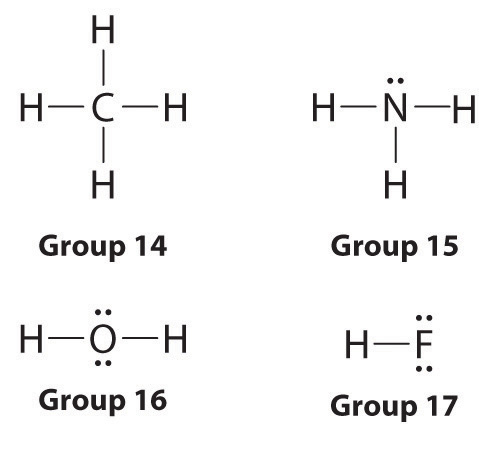
Elements may form multiple bonds to complete an octet. In ethylene, for example, each carbon contributes two electrons to the double bond, giving each carbon an octet (two electrons/bond × four bonds = eight electrons). Neutral structures with fewer or more bonds exist, but they are unusual and violate the octet rule.
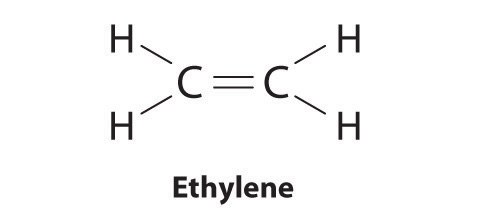
Lewis structures explain why the elements of groups IVA–VIIA form neutral compounds with four, three, two, and one bonded atom(s), respectively.
Allotropes of an element can have very different physical and chemical properties because of different three-dimensional arrangements of the atoms; the number of bonds formed by the component atoms, however, is always the same. Diamond is a hard, transparent solid; graphite is a soft, black solid; and the fullerenes have open cage structures. Despite these differences, the carbon atoms in all three allotropes form four bonds, in accordance with the octet rule.
Elemental phosphorus also exists in three forms: white phosphorus, a toxic, waxy substance that initially glows and then spontaneously ignites on contact with air; red phosphorus, an amorphous substance that is used commercially in safety matches, fireworks, and smoke bombs; and black phosphorus, an unreactive crystalline solid with a texture similar to graphite (Figure \(\PageIndex{3}\)). Nonetheless, the phosphorus atoms in all three forms obey the octet rule and form three bonds per phosphorus atom.

Figure \(\PageIndex{3}\): The Three Allotropes of Phosphorus: White, Red, and Black. ll three forms contain only phosphorus atoms, but they differ in the arrangement and connectivity of their atoms. White phosphorus contains P4 tetrahedra, red phosphorus is a network of linked P8 and P9 units, and black phosphorus forms sheets of six-membered rings. As a result, their physical and chemical properties differ dramatically.
Formal Charges
It is sometimes possible to write more than one Lewis structure for a substance that does not violate the octet rule, as we saw for CH2O, but not every Lewis structure may be equally reasonable. In these situations, we can choose the most stable Lewis structure by considering the formal charge assigned to the atoms. A formal charge is the difference between the number of valence electrons in the free atom and the number assigned to it in the Lewis electron structure. The formal charge is a way of computing the charge distribution within a Lewis structure; the sum of the formal charges on the atoms within a molecule or an ion must equal the overall charge on the molecule or ion. A formal charge does not represent a true charge on an atom in a covalent bond but is simply used to predict the most likely structure when a compound has more than one valid Lewis structure.
To calculate formal charges, we assign electrons in the molecule to individual atoms according to these rules:
- Nonbonding electrons are assigned to the atom on which they are located.
- Bonding electrons are divided equally between the bonded atoms.
For each atom, we then compute a formal charge:
\( \begin{matrix}
formal\; charge= & valence\; e^{-}- & \left ( non-bonding\; e^{-}+\frac{bonding\;e^{-}}{2} \right )\\
& ^{\left ( free\; atom \right )} & ^{\left ( atom\; in\; Lewis\; structure \right )}
\end{matrix} \label{8.5.1} \) (atom in Lewis structure)
To illustrate this method, let’s calculate the formal charge on the atoms in ammonia (NH3) whose Lewis electron structure is as follows:

A neutral nitrogen atom has five valence electrons (it is in group VA). From its Lewis electron structure, the nitrogen atom in ammonia has one lone pair and shares three bonding pairs with hydrogen atoms, so nitrogen itself is assigned a total of five electrons [2 nonbonding e− + (6 bonding e−/2)]. Substituting into Equation \(\ref{8.5.2}\), we obtain
\[ formal\; charge\left ( N \right )=5\; valence\; e^{-}-\left ( 2\; non-bonding\; e^{-} +\dfrac{6\; bonding\; e^{-}}{2} \right )=0 \label{8.5.2}\]
A neutral hydrogen atom has one valence electron. Each hydrogen atom in the molecule shares one pair of bonding electrons and is therefore assigned one electron [0 nonbonding e− + (2 bonding e−/2)]. Using Equation \(\ref{8.5.2}\) to calculate the formal charge on hydrogen, we obtain
\[ formal\; charge\left ( H \right )=1\; valence\; e^{-}-\left ( 0\; non-bonding\; e^{-} +\dfrac{2\; bonding\; e^{-}}{2} \right )=0 \label{8.5.3}\]
The hydrogen atoms in ammonia have the same number of electrons as neutral hydrogen atoms, and so their formal charge is also zero. Adding together the formal charges should give us the overall charge on the molecule or ion. In this example, the nitrogen and each hydrogen has a formal charge of zero. When summed the overall charge is zero, which is consistent with the overall charge on the NH3 molecule.
An atom, molecule, or ion has a formal charge of zero if it has the number of bonds that is typical for that species.
A second way to assign electrons is to draw the Lewis dot structure and then draw a circle around each atom in the structure. The circle should be drawn so that every bond is cut in half, and so that lone pairs on an atom are included in the circle. The electrons in the circle around the atom are the electrons that are assigned to that atom:

The formal charge is calculated by subtracting the number of assigned electrons (in the circle) from the number of valence electrons.
Typically, the structure with the most zero formal charges on the atoms is the more stable Lewis structure. In cases where there are positive or negative formal charges on various atoms, stable structures generally have negative formal charges on the more electronegative atoms and positive formal charges on the less electronegative atoms. The next example further demonstrates how to calculate formal charges.
Example \(\PageIndex{2}\): The Ammonium Ion
Calculate the formal charges on each atom in the NH4+ ion.
Given: chemical species
Asked for: formal charges
Strategy:
Identify the number of valence electrons in each atom in the NH4+ ion. Use the Lewis electron structure of NH4+ to identify the number of bonding and nonbonding electrons associated with each atom and then use Equation \(\ref{8.5.2}\) to calculate the formal charge on each atom.
Solution:
The Lewis electron structure for the NH4+ ion is as follows:
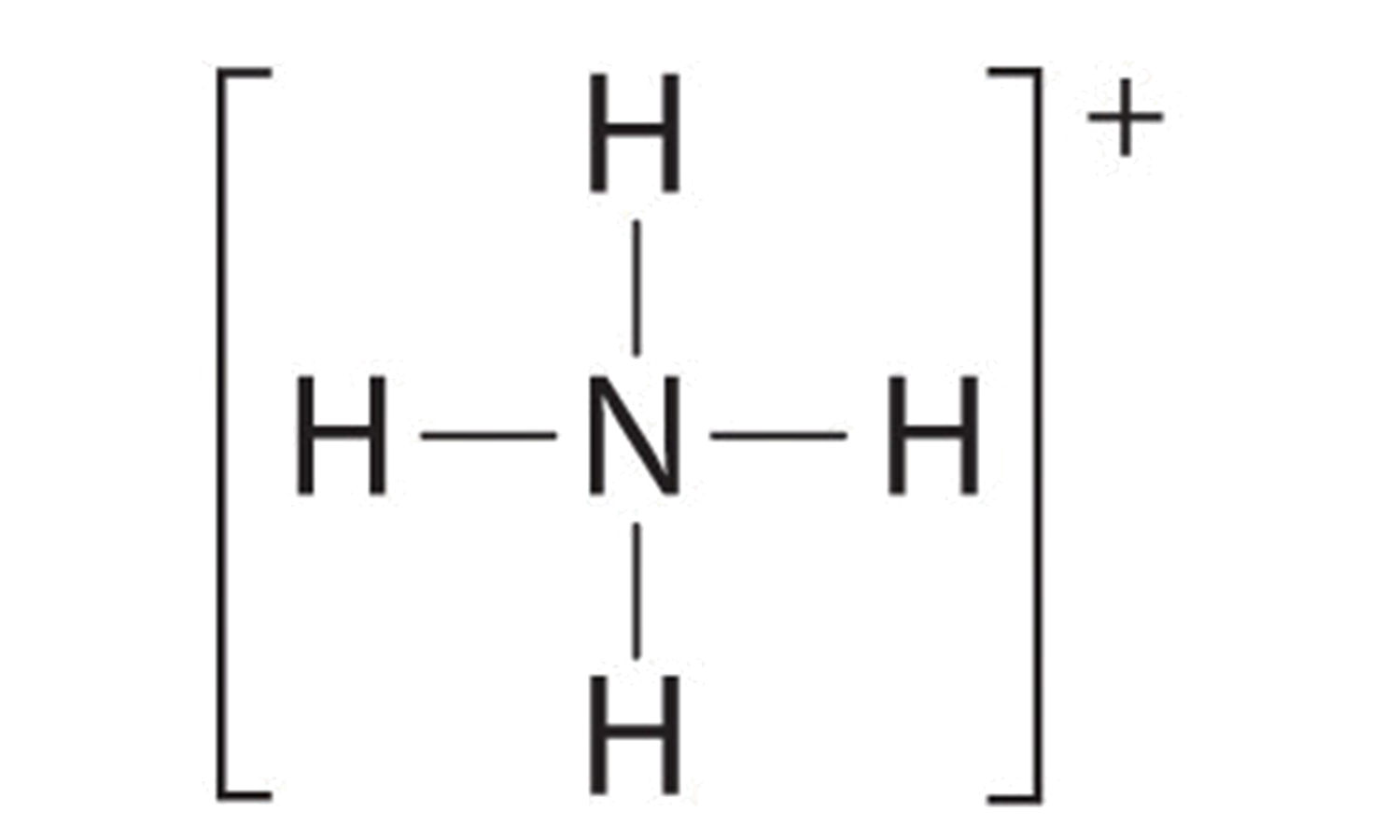
The nitrogen atom shares four bonding pairs of electrons, and a neutral nitrogen atom has five valence electrons. Using Equation \(\ref{8.5.1}\), the formal charge on the nitrogen atom is therefore
\[ formal\; charge\left ( N \right )=5-\left ( 0+\dfrac{8}{2} \right )=0 \]
Each hydrogen atom in has one bonding pair. The formal charge on each hydrogen atom is therefore
\[ formal\; charge\left ( H \right )=1-\left ( 0+\dfrac{2}{2} \right )=0 \]
The formal charges on the atoms in the NH4+ ion are thus
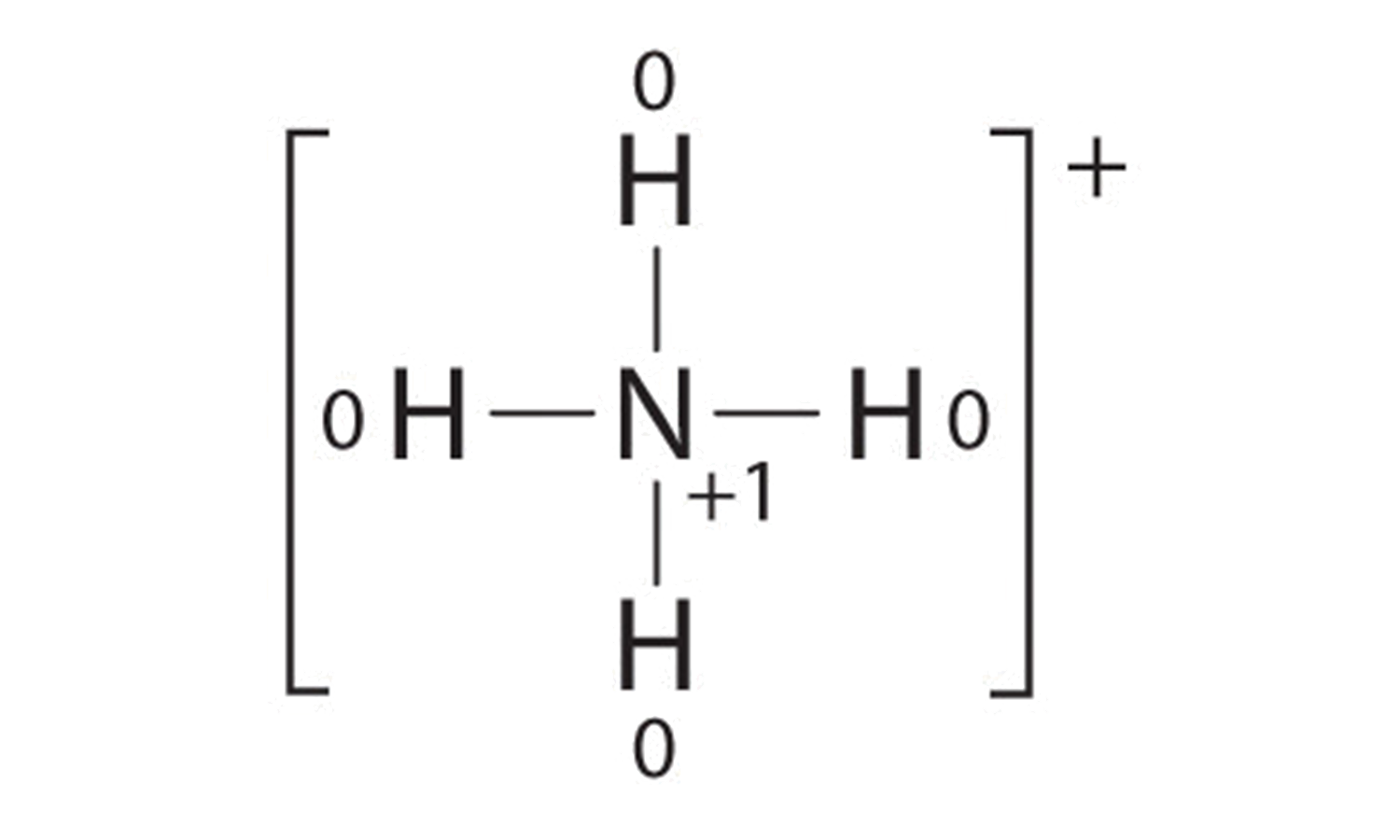
Adding together the formal charges on the atoms should give us the total charge on the molecule or ion. In this case, the sum of the formal charges is 0 + 1 + 0 + 0 + 0 = +1.
Exercise \(\PageIndex{2}\)
Write the formal charges on all atoms in BH4−.
Answer:
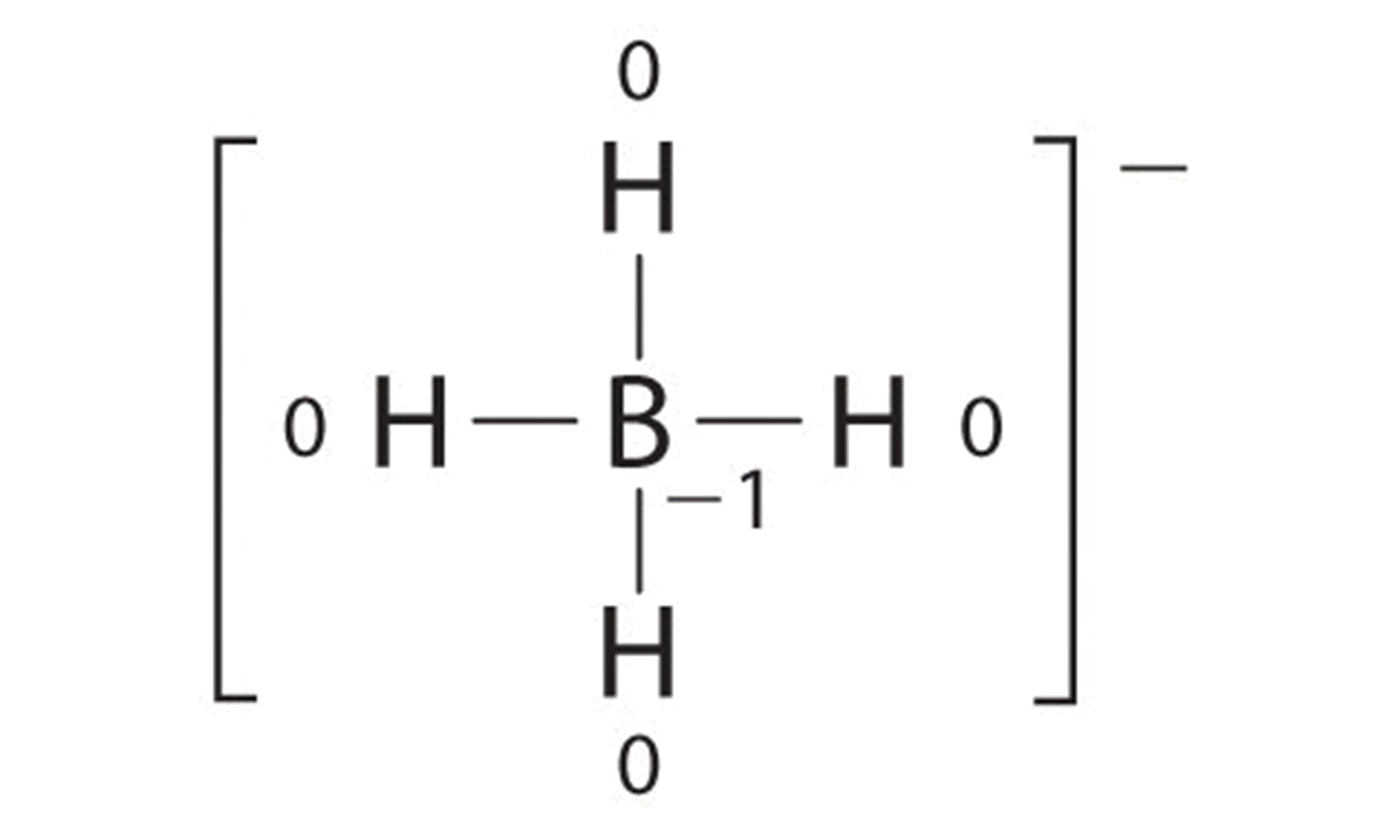
If an atom in a molecule or ion has the number of bonds that is typical for that atom (e.g., four bonds for carbon), its formal charge is zero.
Using Formal Charges to Distinguish Viable Lewis Structures
As an example of how formal charges can be used to determine the most stable Lewis structure for a substance, we can compare two possible structures for CO2. Both structures conform to the rules for Lewis electron structures.
CO2
- (1 C atom) x (8) + (2 O atoms) x (8)= 24 valence electrons needed
- (1 C atom) x (4) + (2 O atoms) x (6) = 16 valence electrons present.
- 24 - 16 = 8 electrons short, thus 8 electrons must be shared
- 8 shared electrons/ 2 electrons per bond = 4 bonds
- Carbon is less electronegative than oxygen, so carbon is the central atom. Connect the two O atoms with the central C atom with one single bond each. You have two more bonds that need to be added to the structure. These two bonds could be added in three different ways:

6. You have used 8 electrons. Add the remaining 8 electrons on to the O atoms as lone pairs to ensure that each atom has an octet:

All three Lewis structures give all three atoms an octet. How do we decide between these three possibilities? First, recognize that the left form and the right form are equivalent; that is they each have one singly-bonded O atom and one triply-bonded O atom. The middle structure is not equivalent to either of the side structures. The formal charges for the two non-equivalent Lewis structures of CO2 are as follows:

Both Lewis structures have a net formal charge of zero, but the structure on the right has a +1 charge on the more electronegative atom (O). Thus the symmetrical Lewis structure on the left is predicted to be more stable, and it is, in fact, the structure observed experimentally. Remember, though, that formal charges do not represent the actual charges on atoms in a molecule or ion. They are used simply as a bookkeeping method for predicting the most stable Lewis structure for a compound.
The Lewis structure with the set of formal charges closest to zero is usually (but not always) the most stable.
Example \(\PageIndex{3}\): The Thiocyanate Ion
The thiocyanate ion (SCN−), which is used in printing and as a corrosion inhibitor against acidic gases, has at least two possible Lewis electron structures. Draw two possible structures, assign formal charges on all atoms in both, and decide which is the preferred arrangement of electrons.
Given: chemical species
Asked for: Lewis electron structures, formal charges, and preferred arrangement
Strategy:
- Use the step-by-step procedure to write two plausible Lewis electron structures for SCN−.
- Calculate the formal charge on each atom.
- Predict which structure is preferred based on the formal charge on each atom and its electronegativity relative to the other atoms present.
Solution:
A Possible Lewis structures for the SCN− ion are as follows:

B We must calculate the formal charges on each atom to identify the more stable structure. If we begin with carbon, we notice that the carbon atom in each of these structures shares four bonding pairs, the number of bonds typical for carbon, so it has a formal charge of zero. Continuing with sulfur, we observe that in (a) the sulfur atom shares one bonding pair and has three lone pairs and has a total of six valence electrons. The formal charge on the sulfur atom is therefore \( 6-\left ( 6+\frac{2}{2} \right )=-1.5-\left ( 4+\frac{4}{2} \right )=-1 \) In (c), nitrogen has a formal charge of −2.
C Which structure is preferred? Structure (b) is preferred because the negative charge is on the more electronegative atom (N), and it has lower formal charges on each atom as compared to structure (c): 0, −1 versus +1, −2.
Exercise \(\PageIndex{1}\): The Fulminate Ion
Salts containing the fulminate ion (CNO−) are used in explosive detonators. Draw three Lewis electron structures for CNO− and use formal charges to predict which is more stable. (Note: N is the central atom.)
Answer:

The second structure is predicted to be more stable.
Summary
Lewis dot symbols provide a simple rationalization of why elements form compounds with the observed stoichiometries. In Lewis electron structures, we encounter bonding pairs, which are shared by two atoms, and lone pairs, which are not shared between atoms. Lewis structures are an attempt to rationalize why certain stoichiometries are commonly observed for the elements of particular families. Neutral compounds of group IVA elements typically contain four bonds around each atom (a double bond counts as two, a triple bond as three), whereas neutral compounds of group VA elements typically contain three bonds. In cases where it is possible to write more than one Lewis electron structure with octets around all the nonhydrogen atoms of a compound, the formal charge on each atom in alternative structures must be considered to decide which of the valid structures can be excluded and which is the most reasonable. The formal charge is the difference between the number of valence electrons of the free atom and the number of electrons assigned to it in the compound, where bonding electrons are divided equally between the bonded atoms. The Lewis structure with the lowest formal charges on the atoms is almost always the most stable one.
Contributors
Modified by Joshua Halpern (Howard University)
- Modified by Tom Neils (Grand Rapids Community College)



